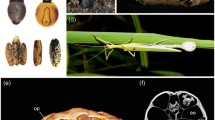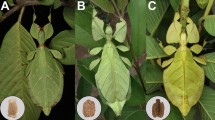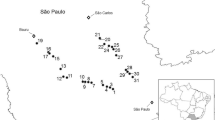Abstract
The egg stages of animal life cycles are underappreciated in terms of their capacity for dispersal, protection, and biotic and abiotic interactions. Some of the most intriguing egg morphologies are seen in stick and leaf insects (Phasmatodea). Phasmids are charismatic insects, particularly due to their incredible camouflage, though a lesser-known fact is that their eggs are incredibly diverse in shape and structure, reflecting varying ecological niches. Perhaps most remarkable are those eggs which appear to resemble plant seeds in both their appearance and means of dispersal, such as via water and animal vectors. Numerous hypotheses surrounding the function of these egg morphologies and their apparent convergence with seeds have been proposed; however, empirical evidence remains lacking. Here, we present an initial synthesis of available evidence surrounding the ecology and dispersal strategies of phasmid eggs and weigh up the evidence for convergent evolution between phasmid eggs and seeds. In doing so, we highlight areas where further research is needed and discuss how the ecology of phasmid eggs may interplay with other aspects of phasmid ecology, distribution, and evolution.



Similar content being viewed by others
Data availability
Not applicable.
References
Abercrombie I (1992) Egg laying by Epidares nolimetangere (de Haan) and Dares ulula (Westwood). Phasmid Stud 1:2–4
Altig R, McDiarmid R (2007) Morphological diversity and evolution of egg and clutch structure in amphibians. Herpetol Monogr 21:1–32
Augspurger CK (1986) Morphology and dispersal potential of wind-dispersed diaspores of neotropical trees. Am J Bot 73:353–363
Baker E (2016) An online taxonomic database of the stick insect (Phasmida) egg-parasitising subfamilies Amiseginae and Loboscelidiinae (Hymenoptera: Chrysididae). Biodivers Data J 4:e7441
Bedford G (1978) Biology and ecology of the Phasmatodea. Annu Rev Entomol 23:125–149
Bohonak AJ (1999) Dispersal, gene flow, and population structure. Q Rev Biol 74:21–45
Bradler S, Cliquennois N, Buckley T (2015) Single origin of the Mascarene stick insects: ancient radiation on sunken islands? BMC Evol Biol 15:196
Bragg PE (2001) Phasmids of Borneo. Natural History Publications, Kota Kinabalu
Brendonck L, Riddoch BJ (1999) Wind-borne short range egg dispersal in anostracans (Crustacea: Branchiopoda). Biol J Linn Soc 67:87–95
Brew CR, O'Dowd J, Rae ID (1989) Seed dispersal by ants: behaviour-releasing compounds in elaiosomes. Oecologia 80:490–497
Brock PD, Hasenpusch JW (2009) The complete field guide to Australian stick and leaf insects. CSIRO Publishing, Collingwood
Burns K (2012) Seed dispersal: the blind bomb maker. Curr Biol 22:R535–R537
Carlberg U (1983) A review of different types of egglaying in the Phasmida in relation to the shape of the eggs and with a discussion on their taxonomic importance (Insecta). Biol Zentralblatt 102:587–602
Carlberg U (1989) Group effect during postembryonic development in Eurycantha calcarata Lucas (Insecta: Phasmida). Fauna Nor 46:101–106
Cernak M, Hasenpusch J (2000) Distribution, biology and conservation status of the peppermint stick insect, Megacrania batesii (Kirby) (Phasmatodea: Phasmatidae), in Queensland. Mem Qld Mus 46:67–68
Cherry M, Gosler A (2010) Avian eggshell coloration: new perspectives on adaptive explanations. Biol J Linn Soc 100:753–762
Church S, Donoghue S, de Medeiros B, Extavour C (2019) Insect egg size and shape evolve with ecology but not developmental rate. Nature 571:58–64
Clark JT (1976) The eggs of stick insects (Phasmida): a review with descriptions of the eggs of eleven species. Syst Entomol 1:95–105
Cliquennois N, Brock PD (2004) Phasmids of Mauritius: Mauritiophasma n. gen., Monognoisis n. gen., Epicharmus Stal 1875 and discussion on their remarkable eggs (Phasmatodea). J Orthop Res 13:1–13
Compton SG, Ware AB (1991) Ants disperse the elaiosome-bearing eggs of an African stick insect. Psyche (Stuttg) 98:207–214
Couvreur M, Christiaen B, Verheyen K, Hermy M (2004a) Large herbivores as mobile links between isolated nature reserves through adhesive seed dispersal. Appl Veg Sci 7:229–236
Couvreur M, Vandenberghe B, Verheyen K, Hermy M (2004b) An experimental assessment of seed adhesivity on animal furs. Seed Sci Res 14:147–159
Dean W, Milton S, Siegfried W (1990) Dispersal of seeds as nest material by birds in semiarid karoo shrubland. Ecology 71:1299–1306
Evangelista D, Hotton S, Dumais J (2011) The mechanics of explosive dispersal and self-burial in the seeds of the filaree, Erodium cicutarium (Geraniaceae). J Exp Biol 214:521–529
Fischer RC, Richter F, Hadacek F, Mayer V (2008) Chemical differences between seeds and elaiosomes indicate an adaptation to nutritional needs of ants. Oecologia 155:539–547
Gallaher T, Callmander M, Buerki S, Keeley S (2015) A long distance dispersal hypothesis for the Pandanaceae and the origins of the Pandanus tectorius complex. Mol Phylogenet Evol 83:20–32
Giladi I (2006) Choosing benefits or partners: a review of the evidence for the evolution of myrmecochory. Oikos 112:481–429
Goldberg J, Bresseel J, Constant J, Kneubühler B, Leubner F, Michalik P, Bradler S (2015) Extreme convergence in egg-laying strategy across insect orders. Sci Rep 5:7825
Guerra-Grenier E (2019) Evolutionary ecology of insect egg coloration: a review. Evol Ecol 33:1–9
Hallman K, Griebler E (2015) Eggshell types and their evolutionary correlation with life-history strategies in squamates. PLoS ONE 10:e0138785
Heatwole H, Levins R (1972) Biogeography of the Puerto Rican Bank: flotsam transport of terrestrial animals. Ecology 53:112–117
Henneguy LF (1890) Note sur la structure de l’enveloppe de l’oeuf des Phyllies. Bull Société Philomanthique Paris 2:18–25
Hetrick LA (1949) The oviposition of the two-stiped walkingstick Anisomorpha buprestoides (Stoll). Proc Entomol Soc Wash 51:103–104
Horn H, Nathan R, Kaplan S (2001) Long distance dispersal of tree seeds by wind. Ecol Res 16:877–885
Hughes L, Westoby M (1992) Capitula on stick insect eggs and elaiosomes on seeds: convergent adaptations for burial by ants. Funct Ecol 6:642–648
Jackson J (1986) Modes of dispersal of clonal benthic invertebrates: consequences for species’ distributions and genetic structure of local populations. Bull Mar Sci 39:588–606
Katsis A, Davies M, Buchanan K et al (2018) Prenatal exposure to incubation calls affects song learning in the zebra finch. Sci Rep 8:15232
Kilner R (2006) The evolution of egg colour and patterning in birds. Biol Rev 81:383
Kimsey LS (2012) Review of the odd chrysidid genus Loboscelidia Westwood, 1874 (Hymenoptera, Chrysididae, Loboscelidiinae). ZooKeys 213:1–40
Kobayashi S, Usui R, Nomoto K, Ushirokita M, Denda T, Izawa M (2014) Does egg dispersal occur via the ocean in the stick insect Megacrania tsudai (Phasmida: Phasmatidae)? Ecol Res 29:1025–1032
Krombein KV (1956) A generic review of the Amiseginae, a group of Phasmatid egg parasites, and notes on the Adelphinae (Hymenoptera, Bethyloidea, Chrysididae). Trans Am Entomol Soc 82:147–215
Krombein KV (1983a) Biosystematic studies of Ceylonese wasps, XI: a monograph of the Amiseginae and Loboscelidiinae (Hymenoptera: Chrysididae). Smithson Contrib Zool
Krombein KV (1983b) Three new egg parasites of South African walking sticks (Hymenoptera: Chrysididae, Amiseginae). J Entomol Soc S Afr 46:139–146
Kulbaba M, Tardif J, Staniforth R (2009) Morphological and ecological relationships between burrs and furs. Am Midl Nat 161:380–392
Lengyel S, Gove AD, Latimer AM, Majer JD, Dunn RR (2009) Ants sow the seeds of global diversification in flowering plants. PLoS ONE 4:e5480
Lengyel S, Gove AD, Latimer AM, Majer JD, Dunn RR (2010) Convergent evolution of seed dispersal by ants, and phylogeny and biogeography in flowering plants. Perspect Plant Ecol Evol Syst 12:43–55
Lomascolo S, Schaefer HM (2010) Signal convergence in fruits: a result of selection by frugivores? J Evol Biol 23:614–624
Mainwaring M, Hartley I, Lambrechts M, Deeming C (2014) The design and function of birds’ nests. Ecol Evol 20:3909–3928
Montgomerie R, Weatherhead P (1988) Risks and rewards of nest defence by parent birds. Q Rev Biol 63:167–187
Muñoz J, Felicísimo ÁM, Cabezas F, Burgaz AR, Martínez I (2004) Wind as a long distance dispersal vehicle in the Southern Hemisphere. Science 304:1144–1147
Murray DR (1986) Seed dispersal. Academic Press, Sydney
Nathan R, Schurr FM, Spiegel O, Steinitz O, Trakhtenbrot A, Tsoar A (2008) Mechanisms of long-distance seed dispersal. Trends Ecol Evol 23:638–647
Orłowski G, Czaranecka J, Goławski A et al (2016) The effectiveness of endozoochory in three avian seed predators. J Ornithol 157:61–73
Panov V, Caceres C (2007) Role of diapause in dispersal of aquatic invertebrates. In: Diapause in Aquatic Invertebrates Theory and Human Use. Springer
Pincel T, Brendonck L, Vanschoenwinkel B (2016) Propagule size and shape may promote local wind dispersal in freshwater zooplankton-a wind tunnel experiment. Limnol Oceanogr 61:122–131
Refsneider J, Janzen FJ (2010) Putting eggs in one basket: ecological and evolutionary hypotheses for variation in oviposition-site choice. Annu Rev Ecol Evol Syst 41:39–57
Robertson J, Bradler S, Whiting MF (2018) Evolution of oviposition techniques in stick and leaf insects (Phasmatodea). Front Ecol Evol 6:216
Royle N, Smiseth N, Kölliker M (2012) The evolution of parental care. Oxford University Press, Oxford
Sellick J (1988) The capitula of phasmid eggs: an update with a review of the current state of phasmid ootaxonomy. Zool J Linnean Soc 93:273–282
Sellick J (1994) Phasmida (stick insect) eggs from the Eocene of Oregon. Palaeontology 37:913–922
Sellick J (1997a) The range of egg capsule morphology within the Phasmatodea and its relevance to the taxonomy of the order. Ital J Zool 64:97–104
Sellick J (1997b) The “umbrella” spines and other surface projections of some phasmid eggs and some comments on phasmid taxonomy. Phasmid Stud 6:15–20
Sellick J (1997c) Descriptive terminology of the phasmid egg capsule, with an extended key to the phasmid genera based on egg structure. Syst Entomol 22:97–122
Severin HHP (1910) A study on the structure of the egg of the walking-stick, Diapheromera femorata Say; and the biological significance of the resemblance of phasmid eggs to seeds. Ann Entomol Soc Am 111:83–89
Shelomi M (2011) Phasmid eggs do not survive digestion by quails and chickens. J Orthop Res 20:159–162
Smith J (1994) Patterns of disseminule dispersal by drift in the north-west Coral Sea. N Z J Bot 32:435–461
Sorensen A (1986) Seed dispersal by adhesion. Annu Rev Ecol Syst 17:443–463
Stanton A, Dias D, O’Hanlon JC (2015) Egg dispersal in the Phasmatodea: convergence in chemical signaling strategies between plants and animals? J Chem Ecol 41:689–695
Stockard CR (1908) Habits, reactions, and mating instincts of the ‘walking-stick’, Aplopus mayeri. Publ Carnegie Inst Wash 103:43–59
Suetsugu K, Funaki S, Takahashi A, Ito K, Yokoyama T (2018) Potential role of bird predation in the dispersal of otherwise flightless stick insects. Ecology 99:1504–1506
Swaine MD, Beer T (1977) Explosive seed dispersal in Hura crepitans L. (Euphorbiaceae). New Phytol 78:695–708
Tallamy D (2000) Sexual selection and the evolution of exclusive paternal care in arthropods. Anim Behav 60:559–567
Taylor J (1976) The advantage of spacing-out. J Theor Biol 59:485–490
Thiel M, Gutow L (2005) The ecology of rafting in the marine environment. I. The floating substrata. Oceanogr Mar Biol Annu Rev 42:181–264
Thomson FJ, Moles AT, Auld TD, Ramp D, Ren S, Kingsford RT (2010) Chasing the unknown: predicting seed dispersal mechanisms from plant traits. J Ecol 98:1310–1318
Traveset A, Robertson A, Rodríguez-Pérez A (2007) A review on the role of endozoochory in seed germination. Seed Dispersal Theory Its Appl Chang World 78–103
Traveset A, Heleno R, Nogales M (2014) The ecology of seed dispersal. Seeds Ecol Regen Plant Communities 3:62–93
Trueman J, Pfeil B, Kelchner S, Yeates D (2004) Did stick insects really regain their wings? Syst Entomol 29:138–139
Ushirokita M (1998) Eggs of stick insect drifting in the wake of screw pine’s seed. Insectarium 35:108–115
Van de Muetter F, Stoks R, De Meester L (2008) Size selective dispersal of Daphnia resting eggs by backswimmers (Notonecta maculata). Biol Lett 4:494–496
van der Pijl L (1982) Principles of dispersal in higher plants, 3rd edn. Springer-Verlag, Berlin
Wang C-H, Chu Y-I (1982) The morphological study of the egg shell of the Tsuda’s giant stick insect Megacrania alpheus Westwood. NTU Phytopathol Entomol 9:98–109
Wang B, Smith TB (2002) Closing the seed dispersal loop. Trends Ecol Evol 17:379–386
Whiting MF, Bradler S, Maxwell T (2003) Loss and recovery of wings in stick insects. Nature 421:264–267
Windsor DM, Trapnell DW, Amat G (1996) The egg capitulum of a neotropical walkingstick, Calynda bicuspis, induces aboveground egg dispersal by the ponerine ant, Ectatomma ruidum. J Insect Behav 9:353–367
Wong J, Meunier J, Kölliker M (2013) The evolution of parental care in insects: the roles of ecology, life history and the social environment. Ecol Entomol 38:123–137
Yamasaki T (1991) Occurrence of Megacrania alpheus (Cheleutoptera: Phasmatidae) in Iriomote-jima Island, Ryukyus. Proc Jpn Soc Syst Zool 44:49–56
Yeh H, Tseng H, Lin CP et al (2018) Rafting of floating fruit is effective for oceanic dispersal of flightless weevils. J Exp Biol 221:jeb190488
Code availability
Not applicable.
Author information
Authors and Affiliations
Contributions
All authors contributed equally to this work, including the conception, development, and writing of this manuscript.
Corresponding author
Ethics declarations
Conflict of interest
The authors declare that they have no conflict of interest.
Ethics approval
Not applicable.
Consent to participate
Not applicable.
Consent for publication
Not applicable.
Additional information
Communicated by: José Eduardo Serrão
Publisher’s note
Springer Nature remains neutral with regard to jurisdictional claims in published maps and institutional affiliations.
Rights and permissions
About this article
Cite this article
O’Hanlon, J.C., Jones, B.R. & Bulbert, M.W. The dynamic eggs of the Phasmatodea and their apparent convergence with plants. Sci Nat 107, 34 (2020). https://doi.org/10.1007/s00114-020-01690-1
Received:
Revised:
Accepted:
Published:
DOI: https://doi.org/10.1007/s00114-020-01690-1




